The varieties most in demand among gardeners
Florists give preference to certain varieties of culture.
The Qiao sisters
The shrub is known for its two-colored petals:
- on the one hand - pale pink and milky white;
- with the second - crimson and red.
The middle of the buds is golden yellowish. The Kiao Sisters have medium-sized flowers that densely dot the bush.
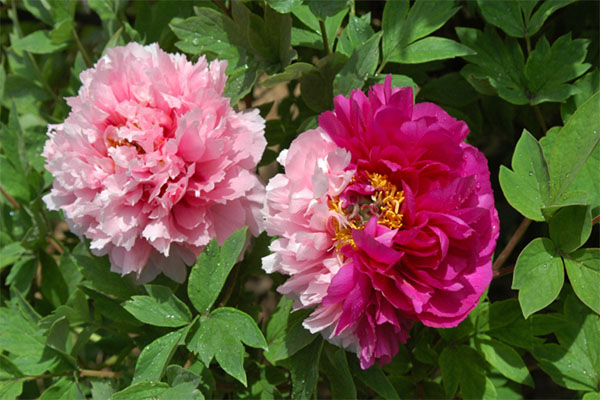
The Qiao sisters
Kinko
Flowers of crown type with a golden tint and bright red edging, with a diameter of up to 17 cm. The plant grows up to 1.5 m, prefers alkaline fertile soils.
Blue Sapphire
It has bluish-pinkish petals with dark purple blotches. It is characterized by rapid growth and development.
Red Giant
Known for short stems and erect red buds. It grows quickly and has many flowers.
Important! Due to its large foliage, it is often used in single plantings.
Green Beans
It is determined by the corrugated terry buds of a pale green color. Refers to late-flowering subspecies with a pleasant aroma.
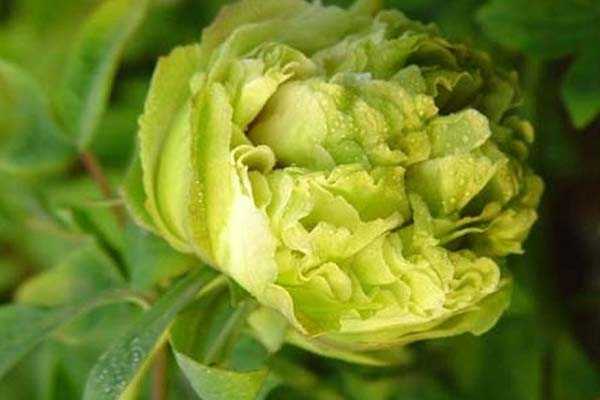
Green Beans
Secret Passion
The medium-sized shrub is covered with red-purple flowers, covered with bright greenery. It is resistant to disease, characterized by early and massive bud opening.
Lily scent
It is famous for its snow-white petals and high growth. The plant is planted in compositions with coniferous and deciduous species.
Hemoza Giant
A tall culture is decorated with light red crown-type buds with a diameter of 16 cm.The bushes have large foliage, they are well adapted to diseases and pest attacks.
Scarlet Sails
Decorated with crown red-purple flowers with a diameter of up to 16 cm. It grows up to 2 m, it can simultaneously eject up to 70 buds.
Important! The shrub is considered one of the most frost-resistant species.
Red Wiz Pink
It grows up to 1.2 m, flowers are wavy, double. Cherry red petals with pale pink strokes, each flower is different in color.
Yaos Yellow
It is characterized by a light yellow shade of flowers, it develops quickly. Requires winter shelter due to poor frost tolerance.
Pink River
The buds resemble lotus flowers with pale pink tones. The plant is known for its unpretentiousness and resistance to diseases and pests.
Pink lotus
The culture has lacy petals with a pale pink tint, stamens of golden and black color. The buds resemble a lotus.
Other
Attention is drawn to the Green ball with spherical flowers of a pale greenish color. After blooming, they turn pink
The plant is tall, the diameter of the buds is up to 18 cm.
Important! Under optimal conditions, the shrub can stretch up to 2 m
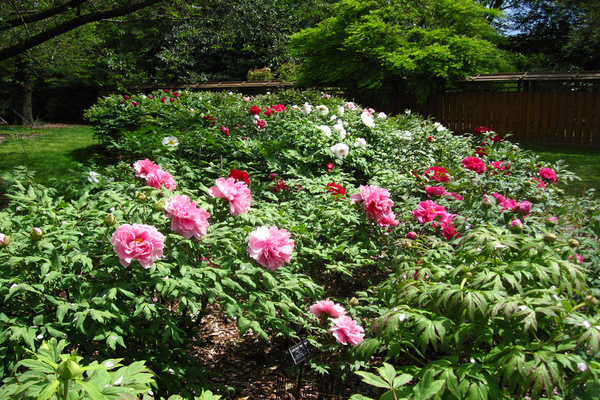
On a personal plot
Popular varieties
Breeders from the USA and Canada are especially fond of our peony. They bred many interesting varieties that differ in the texture and shade of flowers and leaves, as well as the height of the shoots.
Let's take a look at the most popular varieties:
- Rubra Plena: This peony is maroon in color, the flower itself is full, not empty, reminiscent of an ordinary peony. Flowers 10 cm in diameter, velvet. But the deciduous part is the same as that of a thin-leaved peony, but with a bluish tint. It reaches a height of 40-50 cm.
- Tiny Tim: With this hybrid it's the opposite. Its flowers are red, hollow, up to 8 cm, with jagged edges. In general, they look like a "savage ancestor". But the leaves are the same as those of an ordinary peony. This variety is unpretentious to the soil and feels good on alpine slides and rockeries. Reaches a maximum height of 30 cm.
- Kid: although this hybrid has such a name, it reaches a height of 50-55 cm.The flowers are also quite large - 12 cm in diameter. The flower is simple, red, in the sun it gives a lighter, pinkish tint. Pink stamens with yellow anthers. And the greenery of this peony is dark. One of the earliest species.
- Eaglet: This species was developed in the USSR. It reaches a height of 60 cm, a spherical bush, flowers are not very large, red, up to 8 cm.
- Early Scout: This variety took first place at the show in the USA. It blooms in late May, about 50 cm high. The flowers are simple, but large, up to 12 cm, bright crimson. This species is distinguished by its especially dense foliage. It feels like a pine tree is twisted in a spiral around the stem of the peony. Leaves of rich herbal color. In addition, this hybrid is very frost-hardy.
 Figure 3. The best varieties of culture: 1 - Rubra Plena, 2 - Tiny Tim, 3 - Kid, 4 - Eaglet, 5 - Early Scout
Figure 3. The best varieties of culture: 1 - Rubra Plena, 2 - Tiny Tim, 3 - Kid, 4 - Eaglet, 5 - Early Scout
All varieties described are hybrid and are excellent for growing in any climate (Figure 3). Naturally, this culture will need some care. Let's consider it in more detail.
Typical pests and diseases
Insects do not like this plant, so the peony is almost not in danger. Unless the omnivorous aphid does not disdain a peony, and then - from despair. It is very easy to deal with it. A soapy solution with tobacco or garlic infusion will help you. During the flowering period, a sod ant may come to visit, he loves the flower itself. If you know that you have such "comrades", then treat the bushes and the ground around them with special means in advance so as not to spoil the already short flowering.
Of the diseases, only fungal diseases are dangerous, they can arise due to very rainy weather or an incorrect watering schedule. Copper solutions will help.
The thin-leaved peony is a picky inhabitant. And, if you want to settle it in your garden, then it will delight you and your guests for more than one year, expecting practically nothing in return.
Preparation before planting in open ground
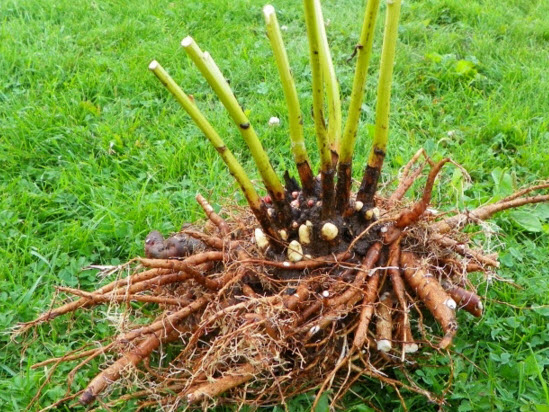
If you want to admire narrow-leaved peonies not only in the photo, but also in your own garden, you should take care of purchasing high-quality planting material. You can find viable seedlings in nurseries or trusted sellers.
Be sure to check the tubers for any damage - rot, fungal diseases, cuts.
Choosing a landing site
Since the thin-leaved peony has a short flowering period, choosing the right place to plant it will prolong its budding. It is best if the area is slightly shaded, with diffused light. Since the plant does not tolerate drafts, it is better to plant the bushes in beds protected from the wind.
Close proximity to trees is undesirable - planting a seedling in a near-stem circle will negatively affect its health. The thing is that the developed root system of trees takes all the nutrients and moisture from the soil, therefore, the Voronet often dies in such conditions.
The narrow-leaved peony belongs to moisture-loving plants, so at this point it is also worth paying attention during planting. Choose a site in the lowland or provide the bush with high-quality watering - for such care it will thank you with healthy, beautiful leaves and lush flowering
How to prepare the soil
The thin-leaved peony does not have special requirements for the soil, however, for lush flowering, it is still better to plant seedlings in loamy soil with a large amount of nutrients.
You should also pay attention to other points:
- The reaction of the soil should be neutral or slightly alkaline. It is easy to determine by weeds - quinoa, bindweed or nettle grow in areas with the indicated soil;
- Suitable for this variety of peony and chernozems with a high content of calcium carbonate;
- Be sure to ensure that the soil is well drained before planting the shrub;
- Acidic soil is not suitable for growing narrow-leaved peony.If there is no way to find another place for planting, lime, wood ash or mineral fertilizers (100 g of superphosphate and 50 g of potassium sulfate) must be added to the soil to neutralize acidity.
Be sure to carefully prepare the site before direct planting. To do this, the soil is dug up, all the weeds are removed along with the rhizomes, the large breasts of the earth are broken until the beds are completely leveled.
Growing a flower, how to plant it in open ground
In order for the plant to please with its excellent appearance and abundant flowering, it is required to plant it correctly and carry out the necessary care.
The description of the variety says that the root cuttings method is used most often. To do this, roots with buds are separated from the rhizome of an adult bush.
Attention! It is recommended to treat the shoots with a solution of potassium permanganate for the prevention of various diseases. After drying, the sections are treated with activated carbon.
The procedure for harvesting planting material is carried out at the end of August.
After drying, the sections are treated with activated carbon. The procedure for harvesting planting material is carried out at the end of August.
Planting prepared rhizomes is carried out in autumn - it is better to choose September for this purpose. If desired, such a plant can be planted in April-May, but this year you should not expect flowering.
Location selection, preparation
Peonies love bright and sunny places without drafts. Good drainage is important for them, they prefer fertile soil.
Before planting, it is required to dig a hole 60 * 60 in size, a drainage layer is laid out at the bottom - gravel, crushed stone. Then a mixture of peat, sand, leafy earth is poured into the hole halfway.
For reproduction, it is better to take a plant aged 3-4 years. You need to carefully dig it out, cut off all the stems. The rhizome is cut into several parts, so that each has a pair of buds and adventitious roots.
Planting procedure step by step
Planting a peony Rosea Plena in the ground is quite simple
It is important to follow all the steps in order:
- A rhizome is placed in a hole prepared and spilled with water.
- The upper kidney should be level with the surface.
- A new sprout is covered with soil, slightly pressed down, watered well.
After a while, you can mulch the place around, using sawdust for this purpose.
Suitable for single and group plantings
Description of the peony Festival Maxim - photo, planting, care:
|
1. Festival of Maxima (lat.Paeonia Lactiflora Festiva Maxima) ‘)); Description:
|
|
|
2. Agricultural technology
Description:
|
|
|
3. Care Description:
|
|
|
4. Reproduction
Description:
|
|
|
5. Use in landscape design
Description:
|
To increase the size of flowers, it is necessary to control the formation of buds and remove all the outer ones, leaving only the central part.
What color are peonies of late varieties (with photo)
In conclusion, we offer you the best varieties of late flowering peonies.
"Arkady Gaidar". Bush 95 cm high, semi-spreading, multi-stemmed. The buds are densely double, hemispherical, bright red, rich crimson shade, 17 cm in diameter. They have a strong pleasant aroma. Stems are strong, densely leafy. The leaves are large, dark green with red veins. The variety is not affected by diseases. Suitable for cutting.
Anshantress. Bred in France at the beginning of the twentieth century. The height of the bush is 90100 cm. The buds are terry, pink-spherical, when blooming is white with a lemon-yellow tint, then they become pure white.Diameter - 18 cm. Has a scent reminiscent of a rose. Collectable stems have a reddish tint on top. The leaves are shiny, dark green in color.
George Peyton. It was bred in the United States in 1938. The bush reaches a height of 90 cm, sparse, sprawling, grows slowly. Terry buds, hemispherical, white-cream color, in the center with a pink tint, sometimes quite saturated, with a diameter of 19 cm. The petals are wide, carved. If it's a hot summer, then in the center of the flower you can see the stamens. The stems are strong. The leaves are large, green. The flower has a faint scent. Differs in abundant flowering.
Gladys Taylor. The bush reaches a height of 80 cm. The buds are terry, spherical, dark pink in color, later they become silvery pink, also acquiring a mother-of-pearl tint. The flower is rather large, 18 cm in diameter. The stems are bent under the weight of the flower. The leaves are large, green. The flower has a pleasant delicate scent. The flowering is quite abundant. Suitable for growing in the Middle Lane. Looks good both in cut and in a flower bed.
Pay attention to the photo of what color peonies are: the variety of colors is amazing!
Planting and leaving
If you decide to grow ravens on your site, then choose a sunny place. In the shade, the peony also grows, but you can not wait for flowering. A little shading from the hot midday sun will not hurt the bush. Narrow-leaved peony cannot be planted in a lowland, it does not tolerate stagnant moisture. Natural habitats - slopes of ravines and gullies, light edges, thickets of bushes. The plant treats its neighbors well. It is placed among conifers, junipers, next to herbaceous peonies.
Soil preparation
The main requirement for the soil at the planting site of the Voronets is high-quality drainage. The moisture must quickly go away so as not to provoke fungal diseases. A suitable soil reaction is neutral or slightly alkaline. A hole with a diameter and depth of 50 cm is prepared for a seedling or root cut. At the bottom, drainage is made of gravel, expanded clay or broken brick 20 cm high. Garden soil is poured on top. Humus, compost, dolomite flour and mineral fertilizer granules are added to it. A loose, fertile mixture will be an excellent soil for flowers.
The best time to plant a plant is August-September. During this period, the terrestrial part ends the growing season. The roots of the plot will take root better without wasting energy on shoots. When planting, do not try to deepen the seedling, the renewal buds should remain at a level of 3-5 cm below the soil surface. Spring plantings are also accepted, but are lagging behind in development.
Flower care
The crow requires a minimum of care. The plant is watered, fed, and the soil is loosened. Near the bush, the soil is loosened by 5-7 cm. Frequent watering is not required, the plant is drought-resistant. It needs moisture during the flowering period. For one watering, 20 liters of water are used. Fertilize it 3 times per season. The first feeding is carried out in early spring, using ammonium nitrate. The second time, during the formation of buds, the peony is fed with complex fertilizer. At the end of the season, a phosphorus-potassium supplement is applied.
In the fall, dried stems are cut to soil level. Mature bushes do not require winter shelter, depending on the variety, they can withstand temperatures down to -40 ° C. Young peonies are covered with spruce branches or non-woven material.
Reproduction methods
Narrow-leaved peonies reproduce by cuttings and seeds. The first method is practiced more often. It does not require significant effort, and the result is always positive. In a large flower bed of an adult narrow-leaved peony (4-5 years old), adventitious roots are formed, which are taken for reproduction. The plant is dug up in early autumn. Delenki with 2-3 buds are cut from the rhizome. Healthy, resilient roots are suitable for reproduction. Places of cuts are treated with fungicidal preparations or charcoal.
After planting in soil enriched with ash, compost and superphosphates, the plant is watered. Top mulch with peat. After the first spring shoots appear, the mulch is removed. One of the advantages of this method is that vegetative reproduction rejuvenates the bush.
Planting with seeds is not the best option, they quickly lose their germination. It is better not to take risks with purchased seeds. Stores offer peonies, which are more likely to be accepted. Seeds collected from their own bushes are sown immediately or stored in the refrigerator until spring. They germinate after 2 years and bloom in the fourth year.
Diseases and pests
Crow is resistant to various diseases, the appearance of rot on the bush is possible only in case of waterlogging. When rust spots appear, the bushes are sprayed with Bordeaux liquid. The pests of the plant include caterpillars and bronzes. May beetles eat stamens and flower petals. In small quantities, beetles do not do much harm to plants. Insecticides "Akiara" will help to get rid of caterpillars. Actellik.
Peony Blossom Pillow Talk
During the flowering period, the plant needs special care.
A period of activity and rest
The flowering period of the peony is short - from late May to mid-June. Rest time falls in August - April.
Peony during flowering
Care during and after flowering
Watering should be abundant during flowering. For one bush, you need to spend 3-6 liters of water. Phosphorus and potassium supplements are also needed.
Important! Several buds are usually formed on the stems. Because of this, the inflorescences are small. During budding, you need to cut off the side buds, leaving only the largest
During budding, you need to cut off the side buds, leaving only the largest one.
After flowering, the fallen petals are immediately collected. If you do not do this, there is a high probability of developing fungal diseases due to mold. Faded buds are immediately cut to foliage.
What to do if it does not bloom, possible reasons
The reasons why the peony does not bloom:
- Deep root collar.
- Too frequent or infrequent bush transplants.
- Lack or excess of nutrients. If the bushes are overfed, they actively build up deciduous mass, but do not bloom.
- Improper care.
- Diseases and pests.
Flowering may not start due to the wrong location: if the peony grows in the shade or the soil is too wet or dry. Stagnation of water is also dangerous for the culture, which leads to the appearance of mold and fungal diseases. Problems can arise if the bushes grow next to the walls of the house or under the crown of trees.
Planting and leaving
Traditionally, it is customary to plant peonies at the end of August or at the beginning of September (in the south it is possible a month later). The place is chosen based on the following criteria:
Good decorativeness - the site should be perfectly visible and attract attention.
Light or light shading for 2-3 hours a day.
A small hill - the Rubra Plena peony does not tolerate lowlands, since moisture accumulates there.
Combination with neighboring bushes or other peonies (optional).
Wind protection.
The site should be prepared in advance. For a month, they dig it up and form several holes with the same diameter and depth (60 cm each). A layer of small stones can be laid on the bottom (especially if groundwater is close to the surface). Then the hole is filled with a mixture of fertile soil (in equal amounts):
- peat;
- sand;
- garden land;
- humus.
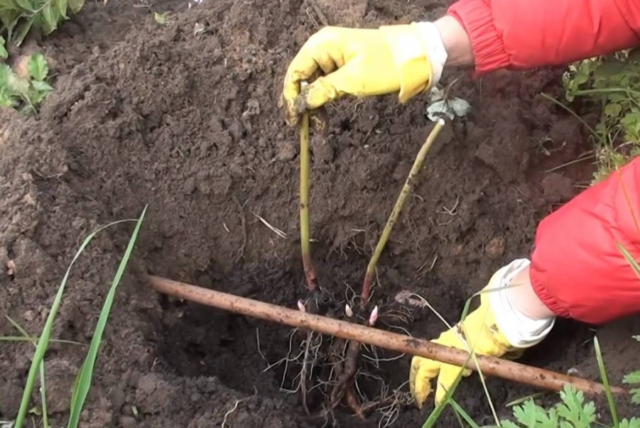
The peony is planted in a deep (about 60 cm) hole
Rubra Plena peony is placed in the center and poured with soil mixture so that the root collar remains above the surface (3-4 cm higher). Make abundant watering (1-2 buckets of settled water at room temperature) and mulch. You can use spruce branches, peat, fallen leaves, hay and other materials at hand.
Attention! For the next two years after planting, the buds of the Rubr Plena peony are recommended to be removed so that the root system grows well.
The bush acquires its maximum size for 4-5 years.
Growing a flower, how to plant it in open ground
In order for the Rubra Plena peony to bloom on the site, you do not need special exquisite measures, but it is imperative to follow agricultural techniques.
Planting by root cuttings
Root cuttings are areas of rhizome, 2-5 cm long, necessarily containing a bud and root. Planting material is prepared in July-August. Algorithm of actions:
- Dig up the rhizome, remove old roots and earth.
- Divide the rhizome into cuttings with at least 1 bud and 1 root.
- Disinfect the cuttings by soaking for 2 hours in a pink solution of potassium permanganate.
- Dry the cuttings, roll the slices in crushed activated carbon, leave overnight.
- In a dug up and fertilized bed, plant the cuttings at a distance of 15 cm from each other.
The plantings are shaded from the sun, watered regularly, weeded as needed, insulated for the winter. Such peonies will bloom in 3 years.
What time is the boarding
Most often, Rubra Plena thin-leaved peony is propagated by dividing the rhizome. Best of all, the plant will tolerate manipulations in late April - early May, or late August - early September. During these periods, a nutritious root system is laid, those roots that suck water from the soil.
Location selection
Bushes can grow and bloom in one place for up to 30 years. The main thing is that it is correctly selected and meets the following conditions:
- a lot of light, the peony will not bloom in the shade;
- nutritious soil, loamy;
- groundwater must be deep, otherwise drainage of the soil;
- do not plant bushes near other perennials, walls of buildings.
How to prepare the soil and flower for planting
The landing site is prepared in 3-4 weeks:
- Dig a hole with a depth and diameter of 60 cm.
- Drainage is organized (expanded clay, pebbles, broken brick).
- The hole is filled ½ with soil, forming a mound.

Correct division of peony rhizome
Plant preparation:
- The stems are cut off the bush.
- Carefully dig out the rhizome.
- The soil is cleaned from the roots so that the buds become visible.
- The accessory roots are cut, leaving 10-12 cm.
- Rotten, dried out areas are removed by sprinkling the cuts with crushed coal.
- The rhizome is divided into parts with a pruner (sharp knife) so that in each division there are 2 adventitious roots and 2-3 developed buds.
Important! The age of the peony to be propagated must be at least 3 years old.
Planting procedure step by step
Landing is carried out according to the following algorithm:
- Part of the rhizome is placed in a prepared and well-watered hole.
- The upper kidney is positioned flush with the ground.
- The hole is covered with soil, compacted.
- Mulch the landing site.
- Water abundantly.

Planting a peony in the garden
Planting with seeds (for breeding)
Getting seeds is troublesome, many hybrids do not bear fruit at all. Features of seed reproduction of peonies:
- seeds sprout tightly and uncommonly;
- only every fifth seed germinates;
- peonies grown from seeds will bloom for 6-7 years;
- the collection of seeds is carried out in August.
After landing in wet sand, a two-stage stratification is carried out:
- Thermal. The sand with seeds is heated twice to +30 ° C. Between and after heating, the sand is watered.
- Cold. When the seeds sprout in the sand, they are transferred to peat pots. The seedlings are kept at a temperature of + 5 ... + 10 ° С for about 3 months.
After stratification, the seedlings are transferred to a room, where they stand until May - the time of transplanting into open ground.
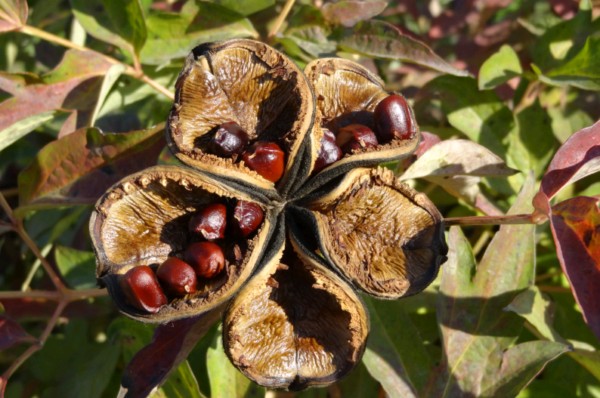
Opened box of peony with seeds
Description of peony thin-leaved Rubra Plena
The herbaceous peony Officinalis Rubra Plena is a very early hybrid created in 1954 in America by the manufacturer Glasscock. The plant blooms in May-June and blooms for 10-15 days. For the winter, the surface parts of the peony die off. The roots of the culture are covered with pineal growths, penetrate deep into the soil, so they do not freeze out in winter and do not require additional shelter.
At the top of the peduncle, 1-2 double flowers with a diameter of 12-14 cm are formed.Up to 20 buds can bloom on the bush at the same time. The bush under the weight of flowers may decay, so it is tied up. Inflorescence petals are shiny, bright, rich dark red hue.
The bush reaches a height of 80-100 cm, minimum - 45 cm, crown diameter - about 85 cm. Stems are thick, erect, not branched, covered with thin dark green leaves, dissected into threadlike lobes. The appearance of the leaves resembles long soft needles. The smell of flowers is very weak.
On a note! Unlike wild steppe species, Rubra Plena peony does not form seeds, therefore it is propagated by dividing the rhizome.
Listed in the Red Book
 Peony blooms are short-lived, but very bright.
Peony blooms are short-lived, but very bright.
Peony tocolist - photo and description:
- In Russia, the narrow-leaved or thin-leaved peony (lat.Paeonia tenuifolia) is known only to a small group of flower growers, as it is a plant in the Red Book. This rare species of peony can still be found in the wild on the steppe and rocky slopes of the Northern Donets. In Russia, the flower is known under the names: Voronets, Voronok, Zelenika, Red lazoric.
- The plant blooms early and is short-lived. From mid-May on the lush bushes bloom bright flowers with a noble aroma. The double flower has a rich, bright red color combined with no less bright yellow stamens. The inflorescence reaches 10 cm in diameter, the simple one consists of 5 rounded petals, and the double one has more than 20. Flowering lasts no more than 2 weeks.
- The leaves of the peony are unusual, dissected into long, thin lobes. The width of one sheet is no more than 2 cm and more like a needle. The bush is compact, dense, spherical, 45 cm high. The formation of the root system occurs in autumn, so this is the best period for transplanting.
- In the garden, the peony is used in the design of alpine slides, stone gardens, and dry mixborders. The plant looks great in landscape design in combination with cereals, perennial flax, saxifrage, broom and wormwood.
- The plant is resistant to disease and frost. It can be cultivated practically throughout the country. In the mountains of the Caucasus and in Altai, you can find white and yellow varieties of narrow-leaved peony, which are also listed in the Red Book.
 Lush bushes bloom profusely.
Lush bushes bloom profusely.
The author of the video recommends planting the narrow-leaved peony in the fall, when the earth is saturated with moisture. So it will take root better and bloom in the spring:
Caring for a peony thin-leaved
Caring for a Peony is a set of very simple rules that you must remember to follow in time:
- mulching the soil to prevent it from drying out around the plant. Thus, you will kill two birds with one stone, the mulch will retain moisture, and also prevent weeds.
- in dry weather, the shrub should be watered 3 times a week.
- do not get carried away with watering, because it will not be difficult to ruin the plant with excessive moisture, evaluating the appearance of the soil
- fertilize the plant in early autumn with phosphorus-potassium mixtures, and in the spring with nitrate or carbamide (50-60 g for one shrub). Abundant nitrogen fertilization leads to a reduction in the number of flowers, lodging of stems and fungal diseases. Starting from the third year after planting, they are looked after depending on the abundance of rainfall. If it's hot, then the amount of fertilizer is reduced, and with an abundance of precipitation, on the contrary, it is increased.
- make it a rule to periodically loosen the soil, but very carefully so as not to harm the plant. Near the roots themselves, you need to loosen about 5-7 cm in depth, and a little further - 10 cm
- the shrub should be periodically rejuvenated in the previously indicated way
- the buds should be removed within the first two years after planting. Be sure to cut them off, otherwise the food will go for flowering, and not for the root system, which is necessary for full growth. Remove the buds that have formed to a size of 7-8mm, so that later the flowers will grow large. The foliage should be cut at the root when it wilts.
- cut flowers at the level of the top leaf, this rule is more decorative in nature, so the seed pods do not spoil the appearance of the plant.
- pests do not like this shrub, but sometimes aphids appear. It is very simple to deal with it, a solution of soap and tobacco infusion copes with it perfectly. At the beginning of the growing season, caterpillars can attack, but ash or dolomite flour can easily cope with such an invasion. Sod ants also love the flowers directly, spraying the bushes and the ground around with special means will help get rid of them.
- fungal diseases due to improper watering, are easily removed by spraying with Bordeaux liquid.
- in order to avoid diseases of peonies, try to plant them as far as possible from other bushes, trees, houses
- in regions with cold winters, the peony should be covered with spruce branches, be sure to close all the roots.


